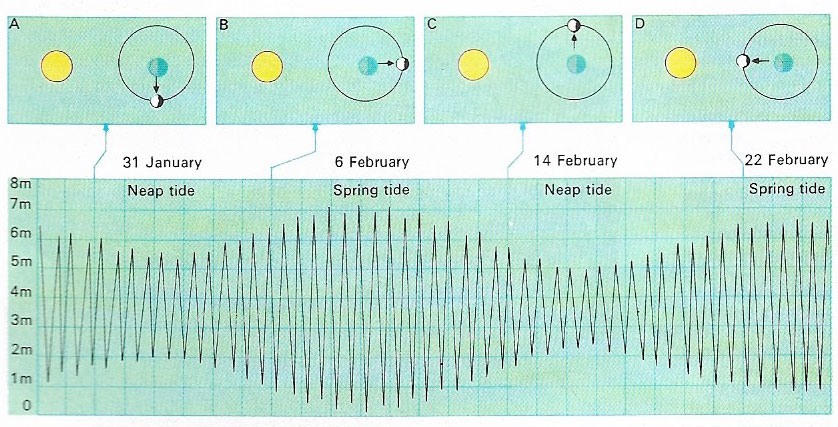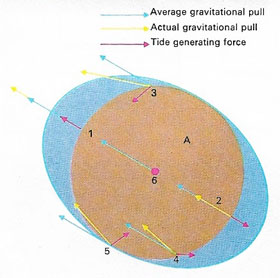tide

The daily rise and fall of the ocean's tides are the result of the gravitational pull of the Moon as it orbits Earth and that of the Sun, though the effect of the latter is less than half as strong as that of the Moon. The effect is greatest on the hemisphere facing the Moon and causes a tidal bulge. When the Sun, Earth, and the Moon are in line, tide-raising forces are at a maximum, and spring tides occur; high tide reaches the highest values, and low tide falls to low levels. When lunar and solar forces are least coincidental, with the Sun and Moon at an angle (near the Moon's first and third quarters), neap tides occur, which have a small tidal.

The height of tides varies according to the positions of the Sun and Moon in relation to Earth. When the Moon is in its first quarter (A), and again when it is in its last quarter (C), the Moon, Earth and Sun form a right-angle. The gravitational forces are therefore opposed, causing only a small difference between high and low tide. Such tides are called neap tides. However, the Moon, Earth and Sun form a straight line at full Moon (B) and at new Moon (D). The high tides then become higher and the low tide lower. These are called spring tides. Becuase of friction and inertia, both spring and neap tides come about two days after the Moon's phases. The graph shows the tidal range over the period of a month..

Fishing boats stranded at low tide in the harbor of a Cornish fishing village.
A tide is an effect that happens when a large object is moving in an orbit in a gravitational field. The object behaves, as far as the field is concerned, as if it were concentrated at a single point, the center of mass. So the center of mass moves in exactly the right orbit. But every part of the object that isn't at the center of mass is in a "wrong" orbit. If the object is a planet orbiting the Sun, for example, bits of the planet that are farther out from the Sun than the center of mass is, are being dragged around faster than their correct orbital speed for their distance from the Sun, and bits of the planet that are closer to the Sun than the center of mass is, are being held back from their correct orbital speeds. The result is tidal forces, which stretch the planet in both directions outward from the center of mass along a line joining the center of mass to the Sun.
Tidal forces produce tides even in the solid surface of a world. But they have a much bigger effect on the oceans. Consequently, there are two bulges of water in the oceans, one on the side of Earth facing the Sun and one on the opposite side. The Moon has double the tide-raising effect of the Sun because it is so much closer. These effects combine at new Moon and at full Moon giving rise to the spring tides.
Ocean tides
Tides are alternate rises and falls of the sea's surface, caused chiefly by the gravitational pull of the Moon and Sun. The tidal effect of the Sun is only 46.6 percent that of the Moon. Tides are also affected by the shapes of ocean basins and land masses. The Moon's gravitational pull makes the waters of the Earth bulge outward when the Moon is ovehead at aany meridian. Another bulge occurs on the opposite side of Earth at the same time. Because the Moon orbits the Earth once every 24 hours 50 minutes, it causes two high tides and two low tides i that period.
 |
| Water on the Earth (A) is attracted to the Moon (B) on the near side but pushed away on the far side. This causes tidal bulges at the nearest (1) and farthest (2) points, tidal flows at (3) and (4) and low tides at median points (5). The force at work (red arrows) is the difference between the Moon's actual gravitational pull and its average pull at Earth's center (6) where it is exactly balanced by centrifugal force. |
Spring tides occur when Earth, the Moon and the Sun are in a straight line. The combined gravitational attraction makes high tides higher and low tides lower, giving a high tidal range. Neap tides, which have the lowest tidal range, occur when the Sun, Earth and the Moon form a right-angle.
In the open sea, the tidal range is no more than a few feet, and in enclosed basins such as the Mediterranean, it is little more than 30 centimeters (12 inches). Howeer, in shallow seas, it may be more than 6 meters (20 feet) and in tidal estuaries 12–15 meters (40–50 feet). The highest tidal range recorded is about 16 meters (53 feet) in the Bay of Fundy in eastern Canada. In some estuaries, including those of Hangchow Bay in China and the Severn in England, tidal bores occur. Bores are bodies of water with a wall-like front that surge up rivers. They form because estuaries act as funnels, leading to a rise in the height of the water as it flows upstream.


